
 2020 Ford Explorer Platinum 4WD
2020 Ford Explorer Platinum 4WD
Class: Midsize Crossover SUV
Miles driven: 239
Fuel used: 13.7 gallons
| CG Report Card | |
|---|---|
| Room and Comfort | B+ |
| Power and Performance | A- |
| Fit and Finish | B+ |
| Fuel Economy | C+ |
| Value | B- |
| Report-card grades are derived from a consensus of test-driver evaluations. All grades are versus other vehicles in the same class. Value grade is for specific trim level evaluated, and may not reflect Consumer Guide's impressions of the entire model lineup. | |
| Big & Tall Comfort | |
| Big Guy | A |
| Tall Guy | A |
| Big & Tall comfort ratings are for front seats only. "Big" rating based on male tester weighing approximately 350 pounds, "Tall" rating based on 6'6"-tall male tester. | |
| Drivetrain | |
| Engine Specs | 365-hp 3.0-liter |
| Engine Type | Turbocharged V6 |
| Transmission | 10-speed automatic |
| Drive Wheels | AWD |
Real-world fuel economy: 17.4 mpg
Driving mix: 50% city, 50% highway
EPA-estimated fuel economy: 18/24/20 (city, highway, combined)
Fuel type: Regular gas
Base price: $58,250 (not including $1095 destination charge)
Options on test vehicle: 21-inch premium aluminum wheels ($595), Premium Technology Package ($995)
Price as tested: $60,935
Quick Hits
The great: Satisfying acceleration; nicely finished interior; plenty of luxury and technology features
The good: Versatile passenger and cargo room; nice balance between ride and handling
The not so good: Mediocre observed fuel economy; steep pricing for a mainstream-brand vehicle
More Explorer price and availability information
John Biel
If we told you that you could choose between two V6-powered, all-wheel-drive, midsize crossover SUVs of roughly the same dimensions—because they’re built off the same platform—and one cost $450 less than the other, which one would you elect to buy?
Not so fast. What if the relatively little extra money bought 35 more horsepower and the added prestige of a luxury brand?
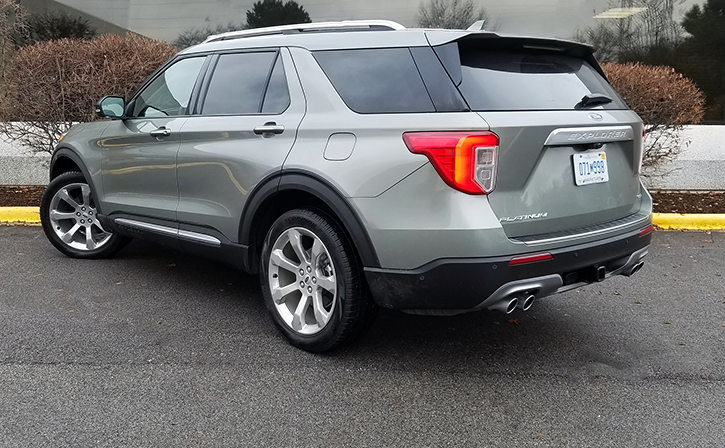
Quick Spin: 2020 Nissan Armada Platinum
That’s where the 2020 Ford Explorer Platinum finds itself. As the plushest model atop the redesigned-for-’20 Explorer line, it is priced right up against the related Lincoln Aviator. In fact, in the price proposition cited above, the Platinum is being compared to the middle model in the trio of gas-engine Aviators. To be absolutely fair, the Explorer Platinum ($59,345 with delivery to start) gets to that point with standard features like a twin-panel moonroof, heated steering wheel and rear seats, and wireless charging that cost extra in the Aviator Reserve—but the Lincoln can be had as a rear-wheel-drive model at a savings of $2510, an option not open to the Ford, where it’s all (-wheel) or nothing.
The Explorer Platinum starts at $3510 more than the performance-oriented ST that Consumer Guide has also tested. That difference buys the moonroof; tri-diamond-pattern perforated-leather seats with accent stitching; Illuminated scuff plates on the front door sills; and satin-aluminum finish on the door-handle inserts, lower-bodyside cladding accent, liftgate appliqué, roof rails, and model-specific grille.
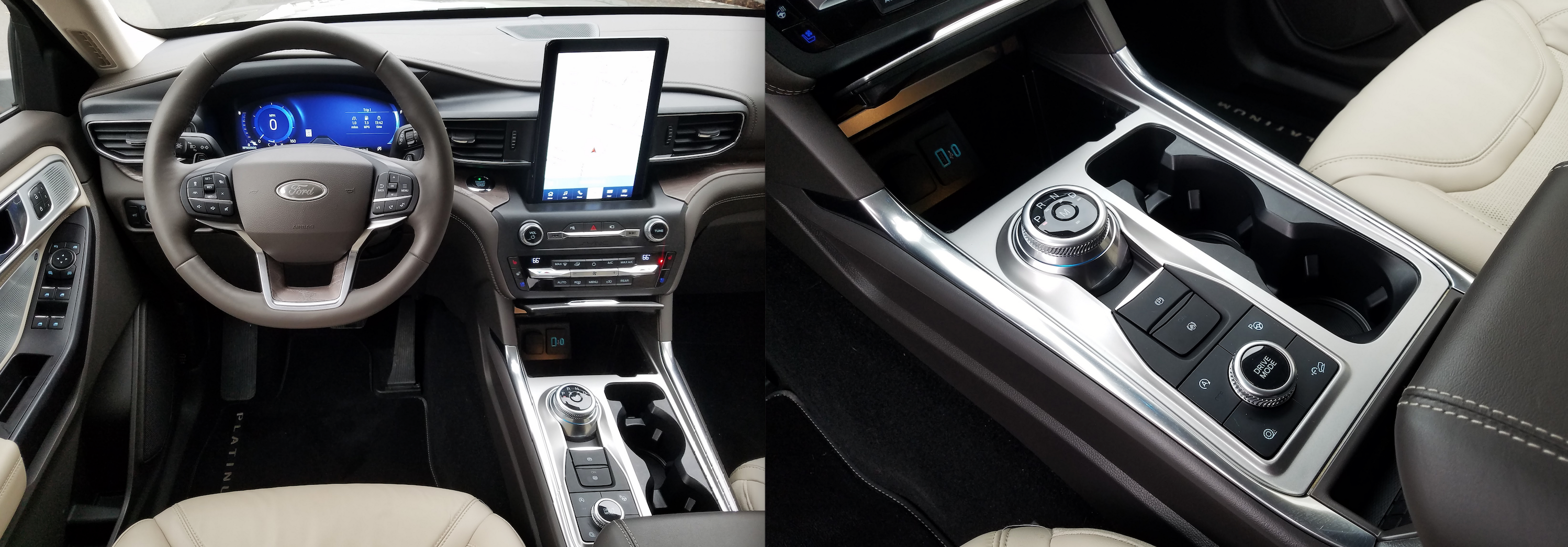
Underhood sits a 3.0-liter EcoBoost V6 with twin turbochargers. In the Platinum it makes 365 horsepower and 380 lb-ft of torque, both of which are 35 shy of the same outputs in the identically sized Explorer ST/Aviator engine. It’s enough of a difference to make a difference. The Platinum doesn’t feel as quick or strong off the line as its higher-powered corporate kin, even in “Sport” mode. It’s still well more than adequate for most buyers’ needs. Towing capacity is the same 5600 pounds as in the ST, and in keeping with its luxury leanings, the exhaust report exiting the quad-tip dual-exhaust outlets is quieter. Paired with a 10-speed automatic transmission, the two V6 Explorers have identical EPA fuel-mileage estimates: 18 mpg in the city, 24 mpg on the highway, and 20 combined. This driver recorded 18.5 mpg from a 110.6-mile test with 35 percent city-type operation.
For 2020, the Explorer/Aviator driveline switches to a longitudinal-engine/rear-wheel-drive basis from a transverse-engine/front-drive core configuration, with the intent of improving ride and handling characteristics. The Platinum lacks the ST’s firmer sport suspension and the Reserve’s adaptive setup. Rolling on optional 21-inch wheels (20-inch alloys are standard), ride still was quite soft in “Normal” mode, and steering was light and maybe a little thin on road feel. Sport tightens up both ride and steering firmness to a degree. Terrain-management settings are included to help on less-than-optimal driving surfaces.
First Spin: 2020 Toyota Highlander
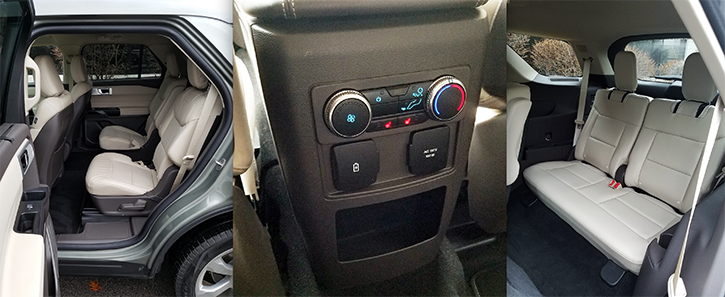
In addition to the model-specific equipment upgrades and appearance features previously mentioned, the Platinum has lots more standard comforts and conveniences. Headlamps and taillamps are LEDs, adaptive up front. A hands-free liftgate, power heated and auto-folding exterior mirrors, trailer sway control, 12-inch digital instrument cluster, illuminated entry, heated and ventilated front seats, power tilt/telescoping steering column, Bang & Olufsen sound system, tri-zone climate control, and woodgrain interior accents are included. Technology items are the Sync3 infotainment system, voice-activated navigation, Active Park Assist, surround-view camera, Wi-Fi hotspot, wireless charging, reverse sensing, and the Ford Co-Pilot360 Assist+ suite of driving aids including adaptive cruise control and automatic emergency braking.
CG’s test vehicle came out to $60,935 with a small complement of options: the 21-inch wheels and the Premium Technology Package with more-powerful 14-speaker audio, 10.1-inch vertical “portrait”-type touchscreen, and multi-contour front seats.
Test Drive: 2020 Hyundai Palisade Limited
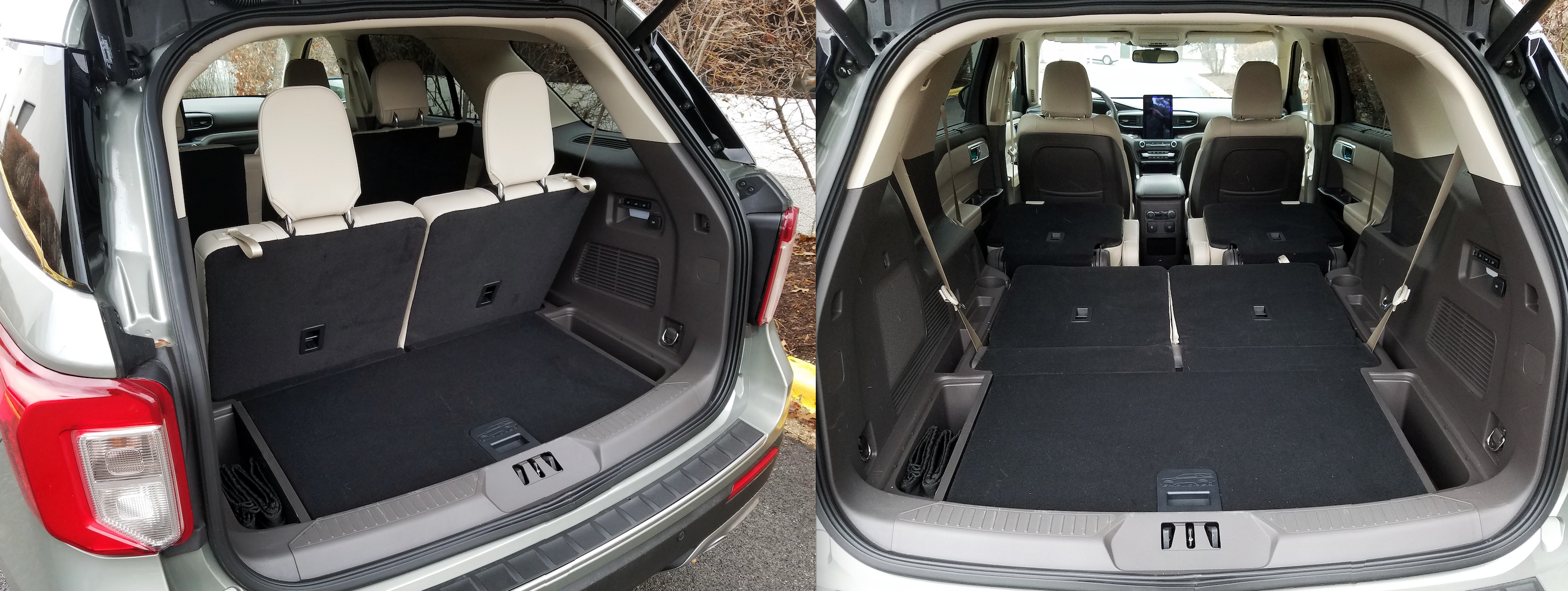
The Platinum seats six with standard second-row individual captain’s chairs, though a split-bench-seat option makes room for a seventh passenger. Headroom and legroom are good in the front two rows, where the seats are firm but comfortable. The 50/50-split third-row seats aren’t as plush, and their level of adult room and comfort is limited. Head- and legroom are decidedly better in the front two rows. Middle seats track forward to ease access to and from the third row. Step-in isn’t especially difficult, and over-the-shoulder driver vision suffers to the rear corners, but isn’t bad elsewhere.
Cabin ambience benefits from generous application of soft-touch surfaces on the dash, console, and doors. Vibrant instrument displays change with the driving-mode selections. There are separate console dials for the mode selector and the automatic transmission. Audio presets are easily entered on the touchscreen, while climate controls are subject to a cluster of buttons, with repetitive-push levers for temperature settings. Storage of personal items is handled by a big glove box, a lighted console box with an upper tray, a covered bin at the front of the console for device inputs and the wireless charger, two exposed cup holders in the console, cup holders and an open tray in the floor-level “consolette” between the captain’s chairs, pouches are on the backs of the front seats, and cup holders and exposed bins molded into the sidewalls of the third row.
Test Drive: 2019 Nissan Pathfinder Rock Creek Edition
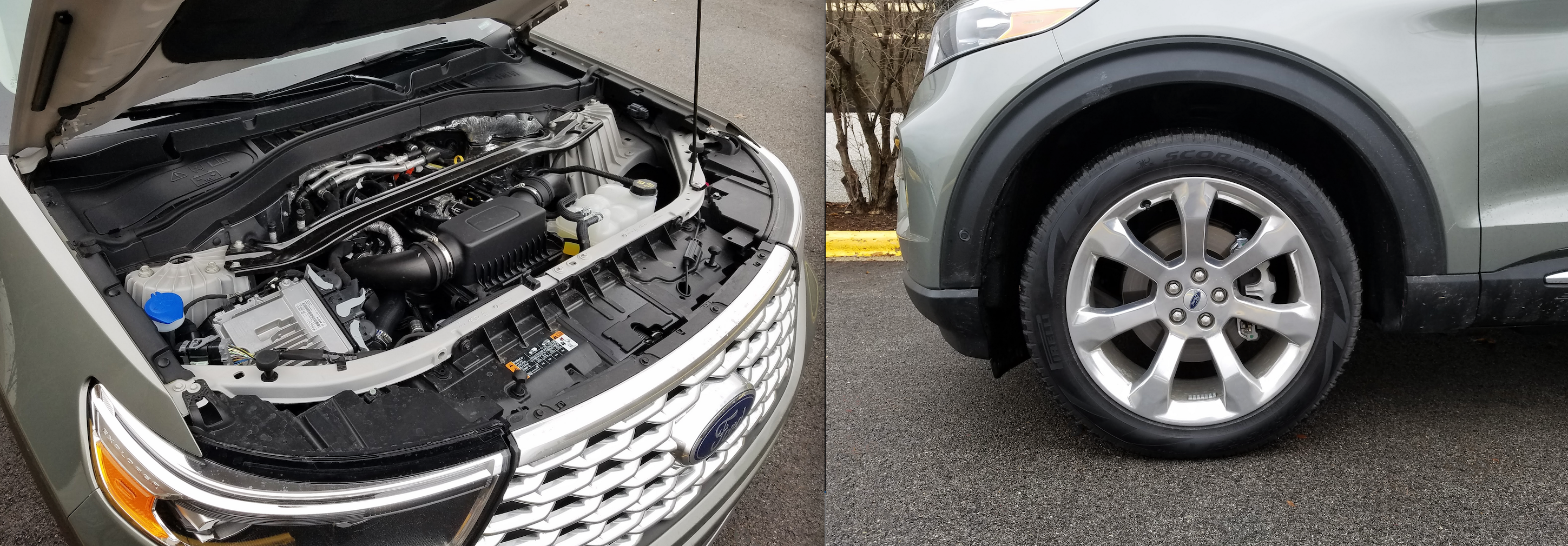
Cargo space—up to 87.8 cubic feet of it with the second- and third-row seats retracted—is better than in the Aviator despite their shared platform. Rear seats can be raised or lowered via buttons in the cargo-bay sidewall. They rest quite flat to create good load space. When retracted, the separate second-row seats leave gaps behind and between them, which may complicate some loading situations. Secure small-item storage is available under the floor panel and in rear-corner bins on either side of the load floor.
The new V6 Explorers take Ford’s popular midsize SUV to a high peak pricewise, though they are loaded with plenty of good things. At least there are models with a turbocharged 4-cylinder engine that deliver some of those good things—and all the utility—for more Ford-like prices.
Test Drive: 2020 Kia Telluride SX

Consumer Guide Car Stuff Podcast episode guide
2020 Ford Explorer Platinum


